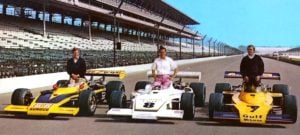It’s been called the Indianapolis 500 that should be forgotten.
Indy car racing was on an unprecedented upswing in May 1973 when practice opened for the 57th running of The Greatest Spectacle in Racing.
Heralded as “The Sport of the ’70s,” USAC’s championship division fulfilled that lofty proclamation with escalated corporate participation, heightened media focus and exploding fan interest.
A dramatic jump in speeds at Indianapolis Motor Speedway also had much to do with that growing fascination. Experiments with barn-door size wings and engines fed with obscene gobs of turbo boost saw lap speeds jump by 30 mph in the decade’s first three years.

When Gordon Johncock flirted with 200 mph during spring testing and Swede Savage did the same on Pole Day eve, it set pundits abuzz.
Pole Day saw 200,000 fans flow into the speedway, expecting a festival of speed. Instead, they encountered the sport’s dark side. During morning practice, popular Art Pollard was killed after he lost control of his car and hit the turn-one wall.
A pall blanketed the crowd and time trails did little to brighten the day. Oh, speeds were fast. Johnny Rutherford won the pole with a track record run, but his best lap fell short of the 200-mph mark.
Pole Day seemed to mark the beginning of a descent into ugliness for that May. In the days following, rain hindered track time. Practice speeds plummeted and the third qualifying day was lost to thunderstorms, hail and a tornado.
The day before the 500, tornadoes ravaged central Indiana. Usually, the days following an Indiana tornado bring clear, sunny skies. Not this time.
Instead of sunshine, race day brought murky, low-hanging clouds that steadily wept moisture. Most expected a postponement announcement at any moment.
However, late in the afternoon, it was announced the race would start in 30 minutes. Competitors voiced concerns that officials were acting too hastily attempting to get the race underway.
Bad things can happen in hurry-up mode at the race track. An ominous atmosphere permeated the grounds. Sure enough, just as the first rows cleared the starting line, all hell broke loose.
Salt Walther lost control in a group of tightly bunched cars jostling for position in midpack. A fiery chain-reaction accident ensued.
Jim McKay, hosting the ABC telecast, shouted, “This is what everyone has feared. This is why there’s been such a terrible atmosphere of fear all weekend long.”
Walther’s car shot sharply to the right, struck Jerry Grant’s car, went airborne and flew into the frontstretch fence. The car’s front half was ripped off, exposing Walther’s feet and legs. The car ricocheted off the fence, flipped and pin-wheeled down the track spewing fuel, fire and debris into the crowd.
When it ground to a stop, the worst was expected. Walther, however, survived. After a long recovery he healed physically and raced again. But he became addicted to painkillers and fought the life-wrecking dependency for the remainder of his days. Walther died of an overdose on Dec. 27, 2012 – another victim of the 1973 500.
The drivers of the other 11 cars involved in the opening-lap melee escaped serious injury. Spectators were not as fortunate, as a dozen were injured. Two teenage girls received life-threatening burns.
With the race red-flagged for the accident, it rained again. The race was postponed until the next day.
In the meantime, some were trying to make sense of what had transpired. A.J. Foyt said, “I don’t know exactly what happened. Salt wasn’t accelerating very well. When he went into another car, I scrunched down in my seat and stood on it. I wanted to get the hell out of that mess.”
No specific blame was assigned, but most agreed that drivers urgently trying to improve their positions, anticipating a rain-shortened race, contributed.
